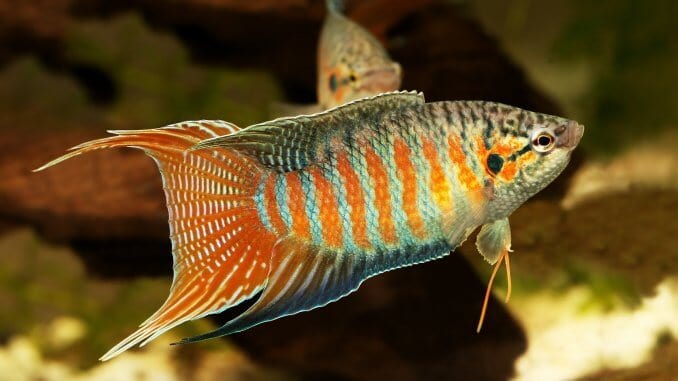
Most people pick fish for their aquarium based on appearance.
Paradise fish initially appeal to people because of their red and blue stripes, but as they are gouramis, people are put off by their aggressive behaviors.
So should you avoid this fish because of its aggression or does their appearance make up for it?
This guide will help you answer this question and more. We will discuss their ideal tank conditions, suitable tank mates, how to breed them, and more…
TABLE OF CONTENTS
Paradise Fish Facts & Overview
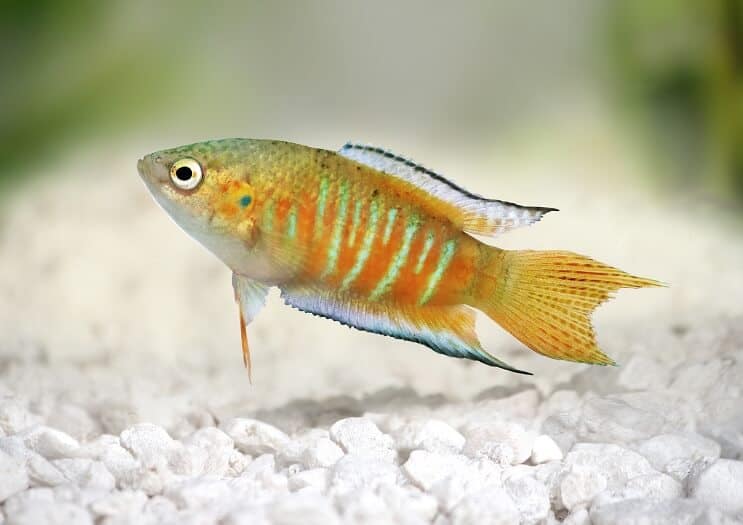
| Category | Rating |
| Care Level: | Medium |
| Temperament: | Aggressive |
| Color Form: | Red and blue stripes |
| Lifespan: | 8-10 years |
| Size: | 2-3 inches |
| Diet: | Omnivore |
| Family: | Osphronemidae |
| Minimum Tank Size: | 20 gallons |
| Tank Set-Up: | Freshwater: heavily planted |
| Compatibility: | Large, peaceful fish |
Paradise fish (Macropodus opercularis) are a freshwater species belonging to the Osphronemidae family. They are a type of gourami so they are also known as paradise gourami.
They’re native to Asia, ranging across Pakistan, India, Taiwan and upwards towards Korea. Here you can find them in most bodies of freshwater.
People are often put off this species because of their aggressive nature. They can be quite difficult to handle so it’s best to have a little experience before adding some to your tank.
Nowadays there are other colorful gourami that are far more peaceful, so the popularity of this species has dropped. It’s worth trying to brave their aggression though, you’ll get an attractive fish covered in bright colors and striking designs. They introduce more activity into the tank with some interesting behaviors too.
Healthy individuals cost around $5, it shouldn’t be too difficult to find some. If they are healthy then they could live up to 8-10 years.
Typical Behavior
Behavior can vary between individuals, but they’re relatively social and active animals. Unlike most other gourami, the paradise variety is particularly aggressive.
Most of this aggression is focused on individuals of the same species, but sometimes other fish get caught in the crossfire.
Fighting can lead to physical damage and health problems, some cases could be fatal.
Watch out for mating behaviors as these are usually a trigger for fighting. Males are the most aggressive and will compete for females, so males should be kept separately. Territory can be an issue as well, but this will just be a case of chasing intruders away.
Fights are intermittent and shouldn’t be a constant worry on your mind. Most of the time they’ll just be swimming around the middle and upper levels of the tank.
Sometimes you’ll see them swim up to the surface, this is to breathe. Most fish use gills to extract oxygen from the water, but some (like paradise fish) have a labyrinth organ that lets them breathe air.
Appearance
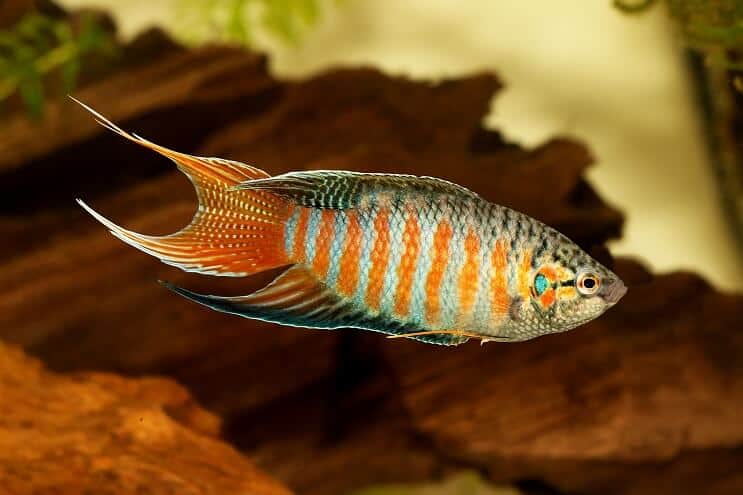
These fish are a colorful choice. They have vivid blue and red stripes that run across their body. The fins don’t tend to have this design, instead they are generally one color. The caudal fin is generally orange.
You may find small black/blue spots scattered across the body.
During mating colors will intensify. The quality of their environment can influence their color too.
This will happen when fighting too, but for a shorter amount of time. The blues will get darker, they’ll extend their fins, and open up their operculum (flap that covers the gills) to look threatening.
It’s not too hard to sex paradise gourami. Males are larger and much more colorful; they’ll develop longer dorsal/anal fins too. Females are duller and smaller, but will grow in size when storing eggs.
Individuals will reach around 2 inches, but sometimes they can grow larger in healthy environments. Their body is sleek with a rounded head. Attached to the body are long flowing fins that can take a few different forms. The caudal fin is the most variable. Usually it’s forked, but it can be rounded or come to a point.
Since these fins are so large they can easily be bitten by fin-nipping fish, so keep them separately.
Habitat and Tank Conditions
Recreating the tropical waters of a paradise gourami’s natural habitat is key to keeping stress levels low in the tank.
Across Asia, they’re usually found in slow-moving, shallow waters, that can vary in condition. This means a wide range of pH and temperature. Something that’s a little more consistent is the abundance of vegetation. These fish prefer densely planted environments that offer both food and shelter.
The bottom of the river or lake would be covered in a sandy substrate with rocks and debris sitting on top (though gourami don’t spend much time interacting with these).
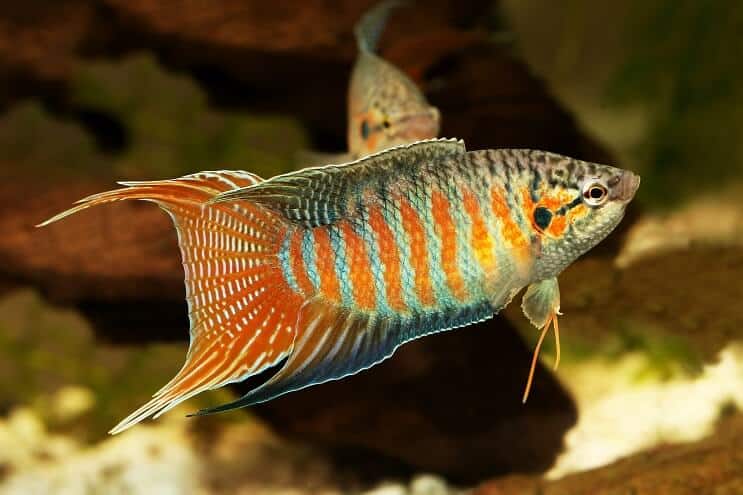
Tank Conditions
When designing any aquarium, you need to think about the needs of your fish.
As fish that swim in the upper levels of the tank, the type of substrate you use isn’t that important. A sandy substrate would most closely resemble their natural habitat.
The plants are a lot more important. Your tank needs planted areas to act as hiding spots.
Hornwort is a good option since it can cope with being eaten now and then. It can be used as a floating plant too which adds a little variety.
You can use rocks to make some caves along the bottom of the tank, but they’ll be empty most of the time.
Keep the tank clean and keep nitrate levels as close to zero as possible by performing 25% water changes every couple of weeks.
Use a heater to maintain a temperature between 70-82°F. pH can be slightly acidic or alkaline (6-8), but extremes can’t be reached. Hardness should be 5-30 dH.
You don’t need any special equipment, just a filter and a heater. Some people add air pumps to their tanks, but this isn’t important because these gourami aren’t used to strong currents and get some oxygen from the air at the surface.
What Size Aquarium Do They Need?
Paradise fish need at least a 20 gallons tank. If you are keeping a small group you will need a 30 gallon tank.
How Many Can Be Kept Per Gallon?
Each paradise fish would need 5 gallons after the 20 gallons for the first fish. For example in a 30 gallon tank you could have 3 paradise gouramis.
Tank Mates
These fish don’t get along well with others, particularly if they’re a similar size or smaller.
They need to be the dominant species in the tank, if you add other aggressive fish then they will compete for control. This will either lead to fights and physical damage, or your paradise fish will hide and live in stress.
As a result, your options for tank mates are limited. Some people choose to keep a species tank to avoid risking incompatible tank mates, but there are a few options available for community aquariums.
The fish you add need to be bigger and peaceful. You can mix in some other gourami species, like pearls or dwarfs. Large goldfish (like comets) shouldn’t be attacked, as well as geophagus cichlids.
Tough cyprinids like bala sharks or large characins will be able to look after themselves too. Fish that live lower down in the tank are more likely to be ignored by paradise fish, but they still need to be big. Loaches and catfish both fit in this category.
You can try bristlenose or cuckoo catfish and yo-yo or clown loaches.
A general rule is to avoid slow swimmers and fish with long fins that can get bitten. This rules out most fancy goldfish.
Adding shrimp or snails can be risky, some individuals will eat them and others won’t. It’s best not to add any if you’re worried about losing them.
Keeping Paradise Fish Together
You can keep these fish in groups, but you need to be able to sex them. Males will fight so only keep one per tank, the rest will have to be females.
They don’t need to be kept in groups though, they’ll be happy living singly. It’s thought that a male is more active on its own rather than in a group.
Paradise Fish Diet
As omnivores, paradise fish will eat lots of different types of foods.
Even though they will eat both plant and animal matter, they should be given a high protein diet. If you want to feed them vegetation, make sure it’s in addition to meats.
Live and frozen foods are a good way to introduce protein into their diet. Things like brine shrimp, mosquito larvae, and bloodworms will be happily accepted.
There are lots of choices for vegetation. Algae wafers and green vegetables are fine. You can even make your own homemade foods.
Your plants could get attacked from time to time but they should survive, especially if you’ve picked a hardy species.
Store-bought flake and pellet foods are easy to find, cheap to buy, and designed to contain a balanced diet.
Twice a day, feed your fish whatever they can eat within a couple of minutes. Breaking up the feeds makes it easier on their digestive system. Remove any excess food to prevent it rotting in the tank and hurting the water quality.
Care
Knowing how to clean your tank is crucial when caring for fish. Poor water quality or excessive algae are a couple of the leading causes for fish disease.
Paradise gourami can get diseases just like any other fish. One that aquarists sometimes see soon after getting them is lymphocystis disease. Pin-pricks growths start to form on the fins. Sometimes this is mistaken for ich (which causes white spots across the body).
It’s usually triggered by stress and eventually the fish will be unable to swim.
Bacterial diseases can become a problem too, like fin rot or dropsy (which causes bloating). Antibacterial treatments are available to treat them.
Most of these diseases can be avoided by keeping the water conditions optimal, carrying out regular water changes and ensuring the fish aren’t stressed.
These fish are quite a hardy species, so they can fend off disease better than others. Constipation can be a problem if you feed them too much or use low quality foods, so stick with the diet advice above to ensure they don’t become constipated.
Signs of constipation include stringy feces, lethargy, lack of appetite and difficulty swimming.
Breeding
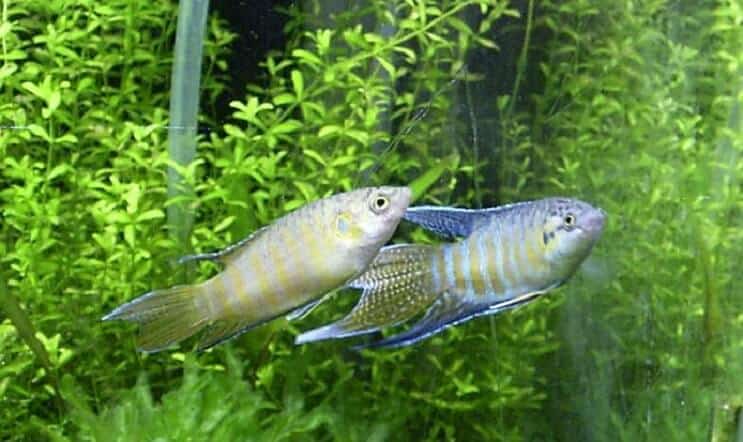
This species can be bred in captivity very easily.
Like bettas and other gourami species, paradise fish are bubble nest builders. A male blows bubbles which float up to the surface; a big enough collection forms a nest. Each bubble is coated in saliva to make them more durable.
A good nest attracts females because they are a safe place to lay eggs. You can tell when a female is ready to mate because they’ll look plump as they fill with eggs.
You will see the male try to court the females, which can lead to some interesting displays. The male will wrap himself around the female a number of times, similarly to when Betta fish breed.
During the process the female will lay eggs, which normally float up to the nest. The pair will repeat this until all the eggs are laid, this can take anywhere from ten minutes to a few hours.
Once the eggs are all safe in the bubble nest, the fry could take anywhere from 30-90 hours to hatch.
After the eggs have been laid, you should remove the male from the tank. They will become very protective over the nest which could mean they will attack the females. They are prone to eating the fry once they have hatched too.
Alternatively you can use a separate tank of around 10 gallons to raise the fry.
If your fish are stressed, then they won’t mate. To eliminate stress you need to do the things that we’ve already mentioned in other sections; keeping the tank clean, feeding the fish a healthy diet and making sure they don’t have any diseases.
Are Paradise Fish Suitable for your Aquarium?
Usually small fish can be added to most community aquariums because they’re not aggressive to tank mates, but paradise fish don’t fit this trend.
If you want to keep paradise fish then your tank needs to be species specific or a community of large, peaceful fish. Any smaller fish will be attacked.
Other than this, setting up a tank with these fish is fairly straightforward. They’re not fussy eaters and they only need some plants to keep them happy.
They will flourish when kept in a healthy environment, showing off their colors and social behaviors.
How do you deal with paradise fish aggression? Let us know in the comments section below…

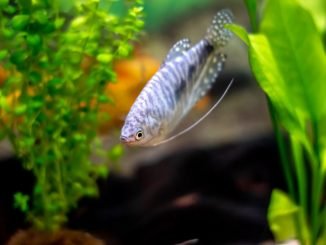
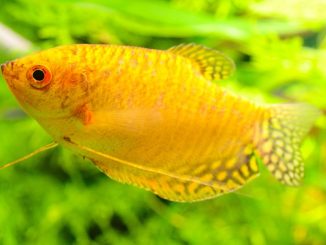
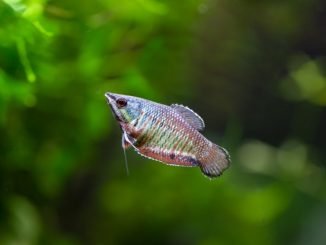
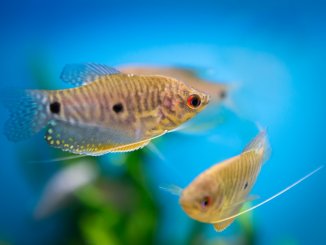
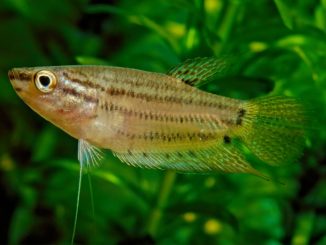
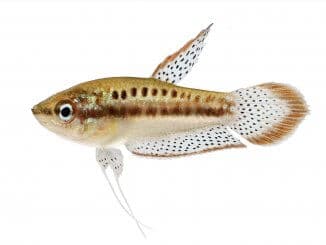
Can you move your paradise fry after they hatched straight away?
Hi Jiao, you should always move the male from the tank as soon as the eggs have hatched, alternatively, you can move the fry to another tank as soon as they start to hatch so long as their water conditions remain exactly the same. Thanks, Robert
I will be getting a pair of paradise fish they will be the gourdians for the tank with 5 citizen blackskirt tetras 2 cory catfish and 1 single male evil emperor gold gourami.
Can paradise fish be placed with angelfish and giant danios?
Hi Ashley, given their quite aggressive nature, I would advise against this. Thanks, Robert
I’m getting a pair of paradise fish as gourdians with 5 citizen blackskirt tetras 2 cory catfish and 1 single male evil emperor gold gourami.
trying to find tank mates for a large school of Odessa barbs (for quick reference Odessa barbs tend to land some where in the 2-3 inch range) some one has suggested Paradise fish I’m hesitant to agree with them due to the aggression levels of Paradise fish do you believe they would be a good match for tank mates or am I better sticking with my gut and not placing a paradise fish with Odessa barbs
it depends on the tank size etc …. but as a rule ime they will go for ANY fish …. I had one that used to go for a full grown Sun bass … then again odessa barbs are very fast , but they do have a very slight resemblance to the Paradise fish .. ime that spells trouble … females on the other hand are usually passive
Can I put a pair of paradise gourami with otocinclus and large mystery snails?
The pet shop person said males were less aggressive so i got two males but they are now fighting. They will bit each ithes mouths and drag to the tank bottom, i am worried about my smaller fish, please advise
Pet shop told me to get two males for a tiny tank and now they are fighting what do i do
Pet shop doesn’t know what they’re talking about! It is not recommended to keep 2 males together. They WILL fight!